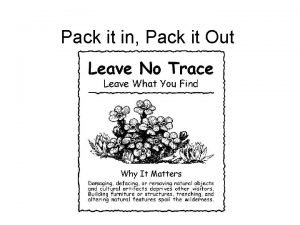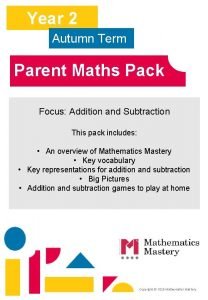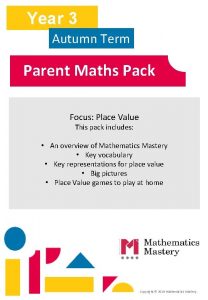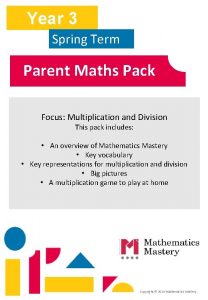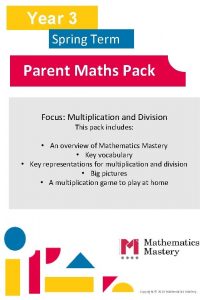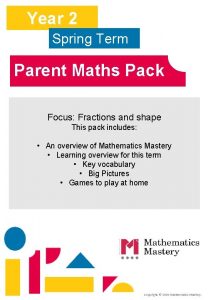Year 1 Autumn Term Parent Maths Pack Focus






- Slides: 6

Year 1 Autumn Term Parent Maths Pack Focus: Addition and Subtraction within 20 This pack includes: • An overview of Mathematics Mastery • Key vocabulary • Key representations for addition and subtraction • Big Pictures • Addition and subtraction games to play at home Copyright © 2019 Mathematics Mastery.

Mathematics Mastery What is ‘Mastery’? The ‘mastery approach’ to teaching mathematics is the underlying principle of Mathematics Mastery. Instead of learning mathematical procedures by rote, we want your child to build a deep understanding of concepts which will enable them to apply their learning in different situations. To achieve this we aim to develop pupils’ Conceptual Understanding, Mathematical Thinking and Language and Communication. (See diagram below). Representing concepts using objects, pictures, words and symbols; making connections Making conjectures, trying out specific examples, organising, comparing, looking for patterns and generalising Conceptual understanding Mathematical problem solving Mathematical thinking Explaining, justifying and discussing using accurate mathematical language Language & communication Central to learning mathematics Success for all At school we believe all pupils can achieve success in maths. We encourage pupils to have a ‘growth mindset’ – a belief that effort leads to success and that challenges are opportunities to learn. Here a few tips to encourage your children at home with maths: ü ü ü Talk to your children about everyday maths Play games with them Value mistakes as learning opportunities Recognise that there is more than one way to work things out. Praise children for effort over outcome. Avoid saying things like “I’m useless at maths”. Copyright © 2019 Mathematics Mastery.

Autumn focus: Addition and Subtraction within 20 Year 1 - Autumn Curriculum Map Numbers to 10 • Represent, compare and explore numbers within 10 • One more and one less • Doubling and halving Addition and subtraction within 10 • Represent and explain addition and subtraction • Commutativity • Addition and subtraction facts Shape and patterns Numbers to 20 Addition and subtraction within 20 • Identify, describe, sort and classify 2 -D and 3 -D shapes • Investigate repeating patterns • Use and follow instructional and positional language • Identify, represent, compare and order numbers to 20 • Doubling and halving • One more and one less • Represent and explain addition and subtraction strategies including ‘Make Ten’ • Use known facts to add and subtract This term, one of our key focuses in Year 1 is addition and subtraction to 20. Below are some of the key small steps pupils will be learning about: • Addition facts to 10 by combining amounts • Subtraction facts to 10 by partitioning • Explore related facts in addition and subtraction • Using number bonds to add within 20 • Using the ‘make ten’ strategy to add within 20 Key vocabulary for Year 1 - addition and subtraction Part Whole Ones Tens Add/Addition Subtract/Subtraction Is equal to (=) Equation - a mathematical statement where two values are equal indicated by the = sign. E. g. 12 + 4 = 16 is an equation. Make Ten strategy - using known facts about number bonds to ten to help you calculate e. g. to work out 7 + 5, we can use 7 + 3 + 2. Number bonds - pairs of numbers that add together to make a different number. E. g. One number bond to 8 is 3 and 5. Partition - to split a number into two or more parts. E. g. we can partition 16 into 10 and 6. The part-whole model When calculating pupils use the language of the parts and the whole. For example, “the parts are 4 and 2, the whole is 6”. Pupils use the part whole model (right) alongside formal equations. Copyright © 2019 Mathematics Mastery. 2

Big Pictures What maths can you see? Discuss with your children at home using the key vocabulary from the previous page. Copyright © 2019 Mathematics Mastery.

Try this at home – workshop games Adding circles For this game, you need dice, a pencil and paper. • Each of you should draw four circles on your piece of paper. • Write a different number between 2 and 12 in each circle. • Roll two dice. (Or roll twice, if you only have one die). Add the two numbers. • If the total is one of the numbers in your circles then you may cross it out. • The first person to cross out all four circles wins. Part Whole Add Is equal to Grab bag Subtraction Choose a number of things to work with, and put that many objects into a bag. • You can use crayons, coins, beans, buttons, etc. • Grab a handful of the items and count them. Ask your partner how many items are now left. “I started with ___ items. I’ve taken out ___. How many are left? ” • Write down the calculation. • Encourage counting up or back, use manipulatives e. g. counters if you need to. • You get a point for getting each calculation correct. • Let your partner have a turn. Part Whole Subtract Is equal to Partition Copyright © 2019 Mathematics Mastery. ?

Try this at home – more ideas Make your own bead string Try using dried pasta and string to make a 010 or 0 - 20 bead string. You can paint or dye the pasta different colours to expose different mathematical concepts. E. g. coloured groups of 2, 5 or 10. Fact of the day/week Have a ‘fact of the day’, e. g. 15 = 7 + 8. Pin this fact up around the house. Practise reading it in a quiet, loud, or squeaky voice. Ask your child over the day if they can recall the fact Ladybird cookies Use red and black icing to decorate biscuits like lady birds. Put one line down the middle and decorate the biscuits with chocolate buttons or chocolate chips on each side. Explore different number bonds. For example how many ways can we arrange the spots to make seven? Dice games Playing with dice can be a great way to support your children with number bonds. If you don’t have a pair of dice, try these online dice: https: //www. random. org/dice/? num=2 Songs Try singing this song with the actions to learn the number bonds to 10: https: //www. bbc. co. uk/teach/supermovers/ks 1 -maths-number-bonds-withmartin-dougan/zf 6 cpg 8 Daily practice: number bonds Challenge your children with missing number problems verbally. Example “The whole is 9. One part is 3. What is the missing part? ” Or, “ I think of a number, I subtract 3 and I am left with 6, what was my number? " Questions to support thinking • What do you think would happen if…. • • What’s the same? What’s different? • • How do you know that? 3 ? 9 3 6 Can you see a pattern? What would come next? What else could go in this set? What couldn’t? Copyright © 2019 Mathematics Mastery. ?
